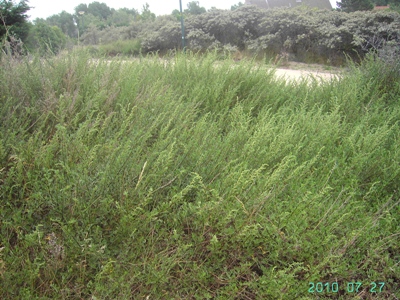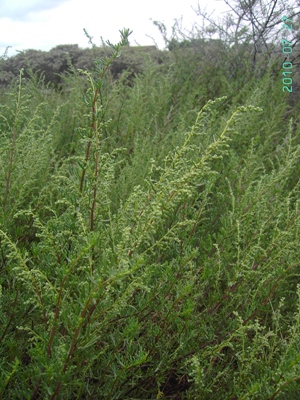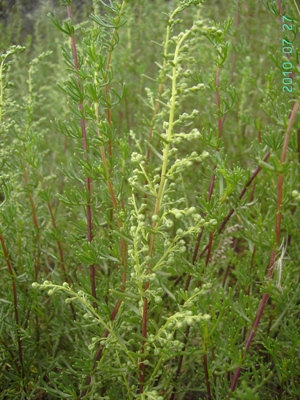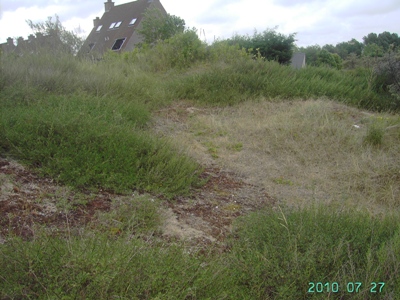Artemisia campestris L. (Eur.) – Two subspecific taxa of Artemisia campestris occur in Belgium but only one, subsp. campestris, is native. They are distinguished in the following couplet:
- Leaves fleshy, not keeled beneath. Heads ca. 3-5 mm wide === subsp. maritima
- Leaves herbaceous, keeled beneath. Heads ca. 1,5-2,5 mm wide === subsp. campestris
Subsp. maritima Arcang. (syn.: A. crithmifolia L., A. lloydii Rouy) was first detected in coastal dunes near De Panne in 2001, probably as an escape from cultivation. An additional population, in the same area, was discovered little later (Van Landuyt 2006). This taxon is now fully naturalised in dry, sunny coastal dunes, always in more or less slightly disturbed vacant lots. A further colonisation in a near future seems likely and invasive behaviour cannot be ruled out (see Weeda 2009).
The exact residence status of subsp. maritima in Belgium seems clear: it recently appeared in a botanically well-explored area and it is rather unlikely that it was previously overlooked. However, its Belgian populations fall within the global distribution of this taxon (western Europe, northwards to the Netherlands; see Tutin & al. 1976). Native status in the Netherlands is usually accepted without doubt although this is very unlikely. Van der Meijden (2005) states that it is also sometimes planted in coastal dunes and according to Weeda (2009) Artemisia campestris subsp. maritima merely is an introduction from western France (formerly introduced for dune fixation and now behaving as an invasive species in disturbed dune grasslands). Recently discovered British populations (Smith & Wilcox 2006, Clement 2006) – in all respects identical with the Belgian and Dutch ones – are claimed to be native.
The taxonomic value of subsp. maritima is debated. An increasing number of taxonomists tend to warrant specific status (see also Stace 2010).
 |
 |
 |
 |
Selected literature:
Clement E.J. (2006) Could Artemisia campestris subsp. maritima be native? BSBI News 103: 4.
García-Fernández A., Vitales D., Pellicer J., Garnatje T. & Vallès J. (2017) Phylogeographic insights into Artemisia crithmifolia (Asteraceae) reveal several areas of the Iberian Atlantic coast as refugia for genetic diversity. Plant Syst. Evol. 303(4): 509-519. [available online at: https://link.springer.com/article/10.1007/s00606-017-1387-x]
Smith P.H. & Wilcox M.P. (2006) Artemisia campestris subsp. maritima, new to Britain, on the Sefton Coast, Merseyside. BSBI News 103: 3.
Stace C. (2010) New flora of the British Isles, 3th ed.: XXXII + 1232 p. Cambridge University Press.
Tutin T.G., Persson K. & Gutermann W. (1976) Artemisia. In: Tutin T.G. & al. (eds.), Flora Europaea, vol. 4. Cambridge University Press, Cambridge: 178-186.
Van der Meijden R. (2005) Heukels’ Flora van Nederland (23e druk). Wolters-Noordhoff, Groningen: 685 p.
Van Landuyt W. (2006) Artemisia campestris. In: Van Landuyt W., Hoste I., Vanhecke L., Van den Bremt P., Vercruysse W. & De Beer D., Atlas van de flora van Vlaanderen en het Brussels gewest. Instituut voor Natuur- en Bosonderzoek, Nationale Plantentuin van België en Flo.Wer: 161.
Weeda E.J. (2009) The role of archaeophytes and neophytes in the Dutch coastal dunes. J. Coast Conserv. 14(2): 75-79.
Van Landuyt W. (2006) Artemisia campestris. In: Van Landuyt W., Hoste I., Vanhecke L., Van den Bremt P., Vercruysse W. & De Beer D., Atlas van de flora van Vlaanderen en het Brussels gewest. Instituut voor Natuur- en Bosonderzoek, Nationale Plantentuin van België en Flo.Wer: 161.

